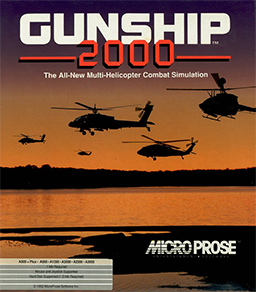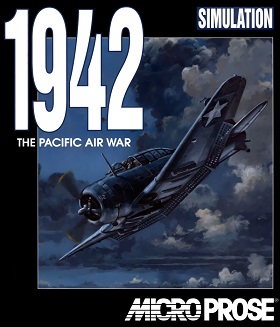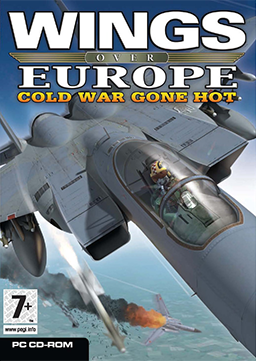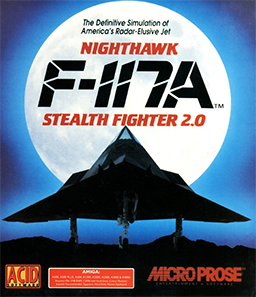
MicroProse is an American video game publisher and developer founded by Bill Stealey, Sid Meier, and Andy Hollis in 1982. It developed and published numerous games, including starting the Civilization and X-COM series. Most of their internally developed titles were vehicle simulation and strategy games.

Silent Service is a submarine simulator video game designed by Sid Meier and published by MicroProse for various 8-bit home computers in 1985 and for 16-bit systems like the Amiga in 1987. A Nintendo Entertainment System version developed by Rare was published in 1989 by Konami in Europe and by Konami's Ultra Games subsidiary in North America. Silent Service II was released in 1990. Tommo purchased the rights to this game and published it online through its Retroism brand in 2015.

Red Baron is a combat flight simulation video game for MS-DOS created by Damon Slye at Dynamix. It was published by Sierra On-Line in 1990. The game was ported for Amiga and Macintosh computers in 1992.

Falcon 4.0 is a combat flight simulation video game developed by MicroProse and published by Hasbro Interactive in 1998. The game is based around a realistic simulation of the Block 50/52 F-16 Fighting Falcon jet fighter in a full-scale modern war set in the Korean Peninsula.

F-19 Stealth Fighter is a combat flight simulator developed and released in 1988 and 1990 by MicroProse, featuring a fictional United States military aircraft. It is the 16-bit remake of the 8-bit game Project Stealth Fighter, which was released for the Commodore 64 in 1987. It was also ported to the NEC PC-9801 in Japan only, and the DOS version was re-released on Steam distribution platform in 2015.
Combat flight simulators are vehicle simulation games, amateur flight simulation computer programs used to simulate military aircraft and their operations. These are distinct from dedicated flight simulators used for professional pilot and military flight training which consist of realistic physical recreations of the actual aircraft cockpit, often with a full-motion platform.

F-15 Strike Eagle II is an F-15E Strike Eagle combat flight simulator released in 1989 by MicroProse and is the sequel of F-15 Strike Eagle. It was followed in 1992 by F-15 Strike Eagle III, the final game of the series.
The Falcon line of computer games is a series of simulations of the F-16 Fighting Falcon combat aircraft. The games, mostly published by Spectrum HoloByte, were noted for their high level of realism unseen in contemporary simulation games.

F-15 Strike Eagle is an F-15 Strike Eagle combat flight simulation game released for Atari 8-bit computers in 1984 by MicroProse then ported to other systems. It is the first in the F-15 Strike Eagle series followed by F-15 Strike Eagle II and F-15 Strike Eagle III. An arcade version of the game was released simply as F-15 Strike Eagle in 1991, which uses higher-end hardware than was available in home systems, including the TMS34010 graphics-oriented CPU.

Gunship 2000 is a helicopter combat flight simulation video game developed and published by MicroProse as a follow-up to their earlier game Gunship. It was originally released in 1991 for DOS; this version received an expansion in 1992. The Amiga, PC-98, Amiga CD32 and PlayStation versions were released in 1993, 1994 and 1996 respectively. A sequel, Gunship!, was released in 2000.

1942: The Pacific Air War is combat flight simulation developed and published by MicroProse for the PC on the DOS operating system in 1994. It is based on the U.S. and Japanese Pacific War conflict from 1942 to 1945. An expansion pack, 1942: The Pacific Air War – Scenario, was released in 1995. A sequel, European Air War, was released in 1998. Tommo purchased the rights to 1942 and digitally publishes it through its Retroism brand in 2015.

F-15 Strike Eagle III is an F-15E Strike Eagle combat flight simulator released in 1992 by MicroProse and is the sequel of F-15 Strike Eagle and F-15 Strike Eagle II. It is the final game in the series.

Wings Over Europe is a PC combat flight simulator game set during the Cold War era where the USSR has attacked NATO forces in West Germany.
Wings Over Israel is a 2008 combat flight simulator computer game for Microsoft Windows covering the three major Middle Eastern conflicts of the 20th century: the Six-Day War (1967), the Yom Kippur War (1973) and the Lebanon War (1982).

F-117A Nighthawk Stealth Fighter 2.0 is the 1991 remake of the 1988-1990 Cold War combat flight simulator video game F-19 Stealth Fighter by MicroProse, itself a remake of 1987's Project Stealth Fighter. The original PC version was updated with a corrected aircraft model once the Lockheed F-117 Nighthawk was declassified and with 256-color VGA graphics instead of the original's 16-color EGA, among other changes.

Flight of the Intruder is a flight simulator developed by Rowan Software and published by Spectrum HoloByte in 1990 for MS-DOS, Amiga, and Atari ST. It was ported to the Nintendo Entertainment System in 1991 with Imagineering as the developer and Mindscape as the publisher. The game is based on the novel of the same name and received as the successor of the first game of the Falcon video game series.

Knights of the Sky is a World War I combat flight simulator designed by Jeff Briggs and published by MicroProse in 1990 for MS-DOS. Ports to the Amiga and Atari ST followed in 1991.

F-16 Combat Pilot is a 1989 F-16 fighter flight simulator created by British software company Digital Integration Ltd. for Amiga, Atari ST, DOS, Commodore 64, Amstrad CPC and ZX Spectrum. It is considered as one of the first combat flight simulators to have a dynamic campaign environment. While the graphics, scenery and audio are quite sparse and basic, the instruments and flight dynamics of a F-16C Fighting Falcon are fully featured and modeled.

Hyperspeed is a space combat role-playing video game developed by MicroProse Software in 1991 for DOS, and is a sequel to Lightspeed.

Jet is a combat flight simulator video game originally published in 1985 by Sublogic. The game was released in 1985 for MS-DOS and the Commodore 64, 1986 for the Apple II, 1988 for the Atari ST and Amiga, and 1989 for the Macintosh and NEC PC-9801.

















